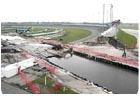
Dewatering pumps from ITT were employed during tunnel construction under Turn 1 at Daytona National Speedway.
Like most construction in Florida, when the venerable Daytona National Speedway began a massive construction project to refurbish its infrastructure, it was necessary to address the dewatering of the construction site. For a complete dewatering package, the Speedway turned to ITT Goulds Pumps' unit.
A Versatile Venue
Daytona International Speedway is the home of “The Great American Race” - the Daytona 500 - as well as many other car, truck and motorcycle races year-round. The enormous 480-acre motor sports complex boasts the most diverse schedule of racing on the globe, thus earning it the title of “World Center of Racing.” In addition to 10 major weekends of racing activity, rarely a week goes by that the Speedway grounds are not used for events that include civic and social gatherings, car shows, photo shoots, production vehicle testing and police motorcycle training.Recently, the Daytona International Speedway undertook a massive construction project to dramatically change the look of the entire infield - the area inside the oval racetrack. Some of the redevelopment plans included a new Nextel Cup Series garage area and a tunnel under Turn 1. The Speedway also plans to fill part of trademark 180-acre Lake Lloyd in the infield to make room for more parking inside the track. Lake Lloyd was created when construction crews in 1958 needed dirt from that area to form Daytona's famous 31-degree banking turns. Once the area was dug out, the Speedway turned it into a water-retention site and named it after a former local car dealer.
Dewatering Required
In order to dewater the surface water from Lake Lloyd, “Trash Hog” model pumps from Goulds (Marlow) Pumps were used. The Trash Hog is a solids-handling, self-priming centrifugal pump, specifically designed to handle wastewater and is capable of handling solids up to 12 inches in diameter.When the Speedway was being built in 1958, it boasted a set of tunnels in Turn 4 that allowed traffic to flow to and from the infield during an on-track event. Those tunnels will remain in place. However, a new tunnel system is going in under Turn 1 that will be more than twice the size of the original tunnels, and will be big enough to allow campers, motor homes and even tractor-trailers to pass under the racing surface. This is crucial for race fans who camp out for days in their recreational vehicles during race events.
Like most areas of Florida, the Speedway is located in an area with a very high water table. In the construction of the tunnel, a tremendous amount of dewatering was required. Rusty Simeone, the market development manager for Goulds Pumps, recommended a dewatering package for the tunnel construction. These pumps primarily were to be used to remove the surface water to permit the construction of the tunnel.
The rest of the pump package consisted of ITT's Red Jacket brand Grizzly 4-inch submersible pumps supplied by All Florida Plumbing in Daytona, Fla. These pump were used to lower the ground water level. The pumps were installed in a set of 64, 5-inch diameter wells down to 60 feet in depth. The pumps all were piped to a common header, and the water was discharged into the local airport canal.
ND
Report Abusive Comment